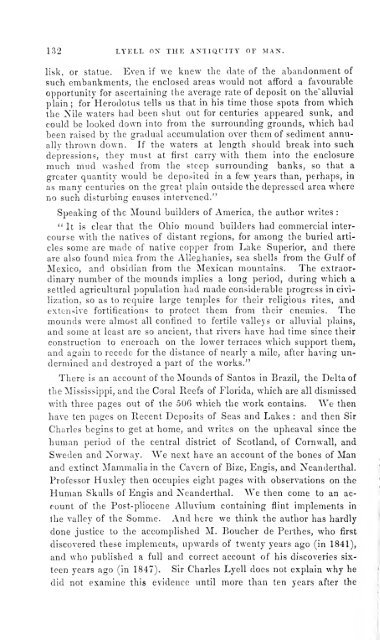The anthropological review - National Library of Scotland
The anthropological review - National Library of Scotland
The anthropological review - National Library of Scotland
Create successful ePaper yourself
Turn your PDF publications into a flip-book with our unique Google optimized e-Paper software.
1,32 LYELL ON THE ANTIQUITY OF MAN.<br />
lisk, or statue. Even if we knew the date <strong>of</strong> the abandonment <strong>of</strong><br />
such embankments, the enclosed areas would not afford a favourable<br />
opportunity for ascertaining the average rate <strong>of</strong> deposit on the' alluvial<br />
plain; for Herodotus tells us that in his time those spots from which<br />
the Nile waters had been shut out for centuries appeared sunk, and<br />
could be looked down into from the surrounding grounds, which had<br />
been raised by the gradual accumulation over them <strong>of</strong> sediment annually<br />
thrown down. If the waters at length should break into such<br />
depressions, they must at first carry with them into the enclosure<br />
much mud washed from the steep surrounding banks, so that a<br />
greater quantity would be deposited in a few years than, perhaps, in<br />
as many centuries on the great plain outside the depressed area where<br />
no such disturbing causes intervened."<br />
Speaking <strong>of</strong> the Mound builders <strong>of</strong> America, the author writes :<br />
" It is clear that the Ohio mound builders had commercial inter-<br />
course with the natives <strong>of</strong> distant regions, for among the buried arti-<br />
cles some are made <strong>of</strong> native copper from Lake Superior, and there<br />
are also found mica from the AUeghanies, sea shells from the Gulf <strong>of</strong><br />
Mexico, and obsidian from the Mexican mountains. <strong>The</strong> extraordinary<br />
number <strong>of</strong> the mounds implies a long period, during which a<br />
settled agricultural population had made considerable progress in civilization,<br />
so as to require large temples for their religious rites, and<br />
extensive fortifications to protect them from their enemies. <strong>The</strong><br />
mounds were almost all confined to fertile valleys or alluvial plains,<br />
and some at least are so ancient, that rivers have had time since their<br />
construction to encroach on the lower terraces which support them,<br />
and again to recede for the distance <strong>of</strong> nearly a mile, after having undermined<br />
and destroyed a part <strong>of</strong> the works."<br />
<strong>The</strong>re is an account <strong>of</strong> the Mounds <strong>of</strong> Santos in Brazil, the Delta <strong>of</strong><br />
the Mississippi, and the Coral Reefs <strong>of</strong> Florida, which are all dismissed<br />
with three pages out <strong>of</strong> the 506 which the work contains. We then<br />
have ten pages on Recent Deposits <strong>of</strong> Seas and Lakes :<br />
and<br />
then Sir<br />
Charles begins to get at home, and writes on the upheaval since the<br />
human period <strong>of</strong> the central district <strong>of</strong> <strong>Scotland</strong>, <strong>of</strong> Cornwall, and<br />
Sweden and Norway. We next have an account <strong>of</strong> the bones <strong>of</strong> Man<br />
and extinct Mammalia in the Cavern <strong>of</strong> Bize, Engis, and Neanderthal.<br />
Pr<strong>of</strong>essor Huxley then occupies eight pages with observations on the<br />
Human Skulls <strong>of</strong> Engis and Neanderthal. We then come to an ac-<br />
count <strong>of</strong> the Post-pliocene Alluvium containing flint implements in<br />
the valley <strong>of</strong> the Somme. And here we think the author has hardly<br />
done justice to the accomplished M. Boucher de Perthes, who first<br />
discovered these implements, upwards <strong>of</strong> twenty years ago (in 1841),<br />
and who published a full and correct account <strong>of</strong> his discoveries six-<br />
teen years ago (in 1847). Sir Charles Lyell does not explain why he<br />
did not examine this evidence until more than ten years after the

















